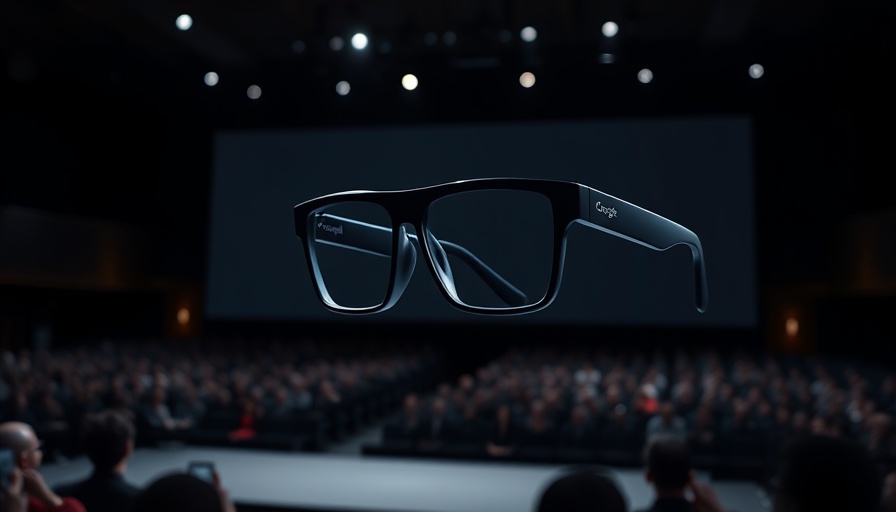
Google's Android XR Glasses: A Revolutionary Leap Forward
In recent years, we've seen a surge of interest in smart glasses and augmented reality (AR) technology, especially as tech giants work to develop wearable devices that seamlessly integrate into our daily lives. Standouts like Google have floated tantalizing ideas, but many might still recall the original Google Glass launch, a spectacle that left consumers skeptical. However, Google's newly unveiled Android XR glasses stand as a testament to lessons learned and technological maturation. This piece will delve into the features, potential applications, and the inevitable questions surrounding these innovative glasses.
In 'Googles New AI Glasses Are The Future Of AI,' the discussion explores groundbreaking advancements in wearable technology, prompting us to dive deeper into what these new innovations can mean for our daily lives.
The AI-Powered Assistant in Your Field of Vision
What's most striking about Google’s Android XR glasses is their integration with Google Gemini's advanced AI capabilities. These smart glasses represent not merely a technical gadget but an AI assistant designed to accompany you everywhere. With the ability to access notifications, respond to texts, capture photos, and even remember detailed visual information, they come equipped to enhance daily interactions with technology. Imagine asking your glasses what books are on a shelf you just glanced at—now they can tell you. This sophisticated memory does more than showcase convenience; it positions users on the frontier of personalized technology.
Transforming Language and Communication
Language barriers have long been a significant thorn in our global interactions, but Google's innovative translation features signal a monumental shift. With real-time translation capabilities, the Android XR glasses can interpret text and spoken words, enabling meaningful conversations across languages. During a demo at the Google IO event, this technology was illustrated excellently as speakers of Hindi and Farsi communicated effortlessly, with translations delivered right before their eyes. For those who travel frequently or work in multicultural environments, this function could revolutionize how we connect with others—potentially diminishing miscommunication and deepening understanding.
Augmented Reality Navigation: A Game Changer
The integration of AR into navigation through the Android XR glasses offers another profound application by projecting turn-by-turn directions directly into the user’s field of vision. Instead of glancing down at your phone, these glasses allow a more intuitive navigation experience, akin to that offered by advanced video game graphics, transforming routine travels into enhanced journeys. This functionality not only increases safety but also makes exploring new environments far more engaging.
Fashion Meets Functionality: The Design Factor
One crucial lesson from the failure of the first Google Glass was aesthetics. The new Android XR glasses are designed to look and feel like regular eyewear, featuring partnerships with popular eyewear brands to ensure user comfort and style. The various models, including basic, mononocular, and binocular displays, cater to different user needs and preferences—making it easier than ever for tech enthusiasts to find a model that fits their lifestyle and optical needs.
Challenges Ahead: Implications for Privacy and Practical Use
Despite the exciting advancements these glasses offer, there are legitimate concerns to consider. One of the most pressing issues is privacy: how will individuals react to the presence of recording devices in everyday interactions? Google's implementation of an LED indicator for the camera is a step toward transparency, but is it enough? Additionally, prospective users may question battery life and durability—two critical factors that can dictate the overall user experience. If these smart glasses can’t sustain a full day of use in real-world conditions, their practicality could be severely limited.
Conclusion: The Future of Wearable Tech Awaits
While skepticism may loom based on previous launches, the Android XR glasses represent a marrying of advanced artificial intelligence with the physical world in an innovative way. As these technologies evolve, they have the potential to redefine how we engage with our surroundings. The implications stretch far beyond consumer tech—they could herald a new era for AI integration in daily life, creating possibilities that were once relegated to the realms of science fiction. This sense of optimism, rooted in substantial technological advancements, suggests we are on the brink of experiencing how such devices might transform our daily routines, personal interactions, and ultimately, productivity.
For those intrigued by technology and eager to see how this will unfold, stay tuned as Google prepares to roll out the Android XR glasses later this year, with developer previews already underway.
 Add Row
Add Row  Add
Add 




Write A Comment